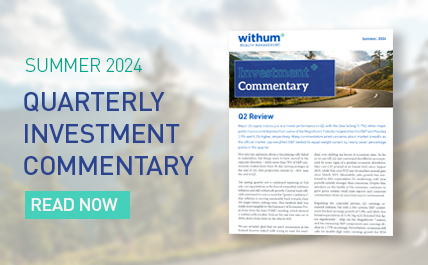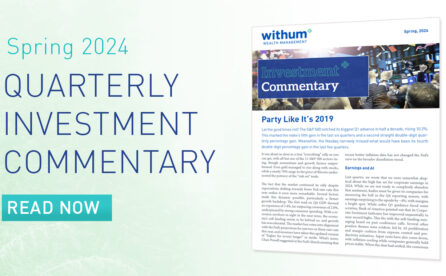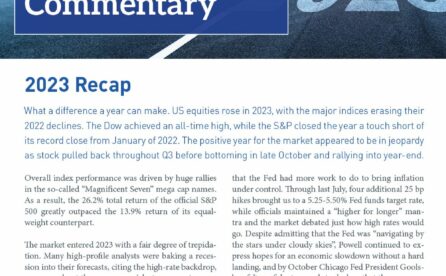
November: The US Cannot Remain Immune From the Rest of the World Forever
Markets in October and early November were mostly distracted from the positive economic news in the U.S. by poor earnings reports, election jitters, and Hurricane Sandy. The earnings reports have not been pretty, with negative news from slowing emerging markets, a weak Europe (and, to a lesser degree, China), and large currency swings. Although the U.S. won’t remain immune to the rest of the world forever, and our fiscal situation remains in disarray, there still are a few factors that will help the domestic economy. These include Boeing’s ongoing ramp-up, a nicely improved and stable auto industry, increased oil production, a relatively stabilized banking industry, and a lumbering housing industry that has finally begun to recover.
GDP: Consumers, the Housing Market, and Government Spending Aid Rising GDP
Third-quarter real GDP grew by 2%, ahead of the second quarter’s 1.3% rate. Much of this improvement was due to a very strong consumer, an improved housing market, and strong government spending. Consumption, which represents about 70% of GDP, is always the most important factor, because if consumers continue to spend, businesses will have to invest in plant and equipment, inventory, and most importantly, employees.
Employment: Jobs Increase but the Recovery is Not Consistent Across Sectors
In October, 171,000 jobs were added, sharply exceeding expectations. While this was great news, Morningstar economists believe that at the current pace of job growth, an additional 23 months is still required to recover pre-recession jobs. Employment recovery across sectors has not been consistent. The overall service sector is nearly back to pre-recession levels, while good-producing sectors (mining, manufacturing, and construction) have only recovered 15% of the jobs lost. Furthermore, massive efficiency gains in manufacturing have moved industrial production levels to near pre-recession levels, even as manufacturing has regained a measly 25% or less of the jobs lost. The unemployment rate inched upward to 7.9%.
Housing: Narrowing Gap Between Pending & Closing Sales May Point to an Improving Housing Market
Despite the arrival of fall, which typically brings a drop in real estate activities, home prices, new home sales, and pending home sales all showed improvement. On a year-over-year basis, the August Federal Housing Finance Agency (FHFA) Home Price Index was up 4.6%, with all nine regions in the U.S. showing positive growth. While almost always moving in the same direction, pending sales (contract executed but not closed) have exceeded closed sales by a large margin for many months, as below-market appraisals and mortgage denials caused many contracts to not close. Recently, the gap between growth in pending and closing sales has narrowed to about 2% from as much as 6%, which Morningstar economists believe points toward an improving housing market.
Manufacturing: Have we Hit a Bottom?
October’s manufacturing data showed gains in new orders and an increase in employment, which suggested that the manufacturing sector in the U.S. may have bottomed and is now recovering. Auto sales in October were better than a year ago, but slumped from 14.9 million units in September to 14.2 million units in October. Hurricane Sandy was most likely the cause of this shortfall, as a large portion of auto sales occur on the last few days of the month, and the area hit by the storm accounted for 20%-25% of all auto sales. Outside of the U.S., China showed meaningful improvement between September and October as the Chinese construction market continued to show signs of bottoming. Europe’s manufacturing, on the other hand, continued to contract and is currently at its lowest level in 40 months.
Election results: The Results are in – Now What?
With President Barack Obama narrowly beating out Republican challenger Mitt Romney to win a second term in office. All attention has now turned to global woes and the looming fiscal cliff. If nothing is resolved by the end of 2012, massive spending cuts and across-the-board tax increases may occur. Markets reacted negatively on Wednesday November 7th, falling by as much as 2.73%, with energy and banking sectors among the hardest hit.
also read:
Avoiding Higher Taxes in 2013 – Year-End Estate & Tax Planning [Updated] »
Dividend Tax Increases: What Should You do with Your Dividend Payers? »
Should You Harvest Capital Gains in 2012? »
You should not assume that any discussion or information contained in the presented material(s) serves as the receipt of, or as a substitute for, personalized investment advice from PWM. To the extent that a reader has any questions regarding the applicability of any specific issue discussed above to his/her individual situation, he/she is encouraged to consult with the professional advisor of his/her choosing. PWM is neither a law firm nor a certified public accounting firm and no portion of the presented material(s) should be construed as legal, accounting or consulting advice. A copy of the PWM’s current written disclosure statement discussing our advisory services and fees is available for review upon request. To ensure compliance with U.S. Treasury rules, unless expressly stated otherwise, any U.S. tax advice contained in this communication (including attachments) is not intended or written to be used, and cannot be used, by the recipient for the purpose of avoiding penalties that may be imposed under the Internal Revenue Code. ©2012 Morningstar, Inc. All Rights Reserved. The information contained herein (1) is intended solely for informational purposes; (2) is proprietary to Morningstar and/or the content providers; (3) is not warranted to be accurate, complete, or timely; and (4) does not constitute investment advice of any kind. Neither Morningstar nor the content providers are responsible for any damages or losses arising from any use of this information. Past performance is no guarantee of future results. “Morningstar” and the Morningstar logo are registered trademarks of Morningstar, Inc. Photo Credit: billsaturno
If You Liked This Article, SHARE IT!
Help Us Spread The Word. Share This Article With Your Friends & Peers


